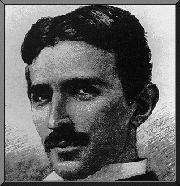 Nicola
Tesla, July 9, 1856, Smiljan, Croatia--d. Jan. 7,
1943, New York City), Tesla discovered the rotating magnetic field,
the basis of most alternating-current machinery. His father was an
Orthodox priest and his mother although illiterate was his
inspiration to enter the sciences. She was a highly intelligent woman
who invented many household and farm implements during her life.
Nicola
Tesla, July 9, 1856, Smiljan, Croatia--d. Jan. 7,
1943, New York City), Tesla discovered the rotating magnetic field,
the basis of most alternating-current machinery. His father was an
Orthodox priest and his mother although illiterate was his
inspiration to enter the sciences. She was a highly intelligent woman
who invented many household and farm implements during her life.
In a revelation that Tesla said "came in a flash" during a walk in the park in 1881, he conceived of using an alternating current to produce a rotating magnetic field that could drive a motor. While working or the Continental Edison Company in Paris, he built the first induction motor. Tesla then came to the United States in 1884 with little money and a letter of introduction to Thomas Alva Edison. While Edison gave Tesla a job as a research assistant in his industrial-research laboratory, he did not work for Edison for very long.
Edison disagreed violently with Tesla about the potential for alternating current and the men were very far apart in manner and temperment. Edison, very much the methodical plodder, was an entirely practical man while Tesla was driven by his periodic flashes of brilliant insight into theoretical leaps of faith. Edison considered alternating current unsafe because of the high voltages it produced and preferred the direct-current system.
The Westinghouse Company used Tesla's system to light the World Columbian Exposition at Chicago in 1893. Westinghouse then won the contract to install the first power machinery at Niagara Falls, which bore Tesla's name and patent numbers. The project carried power to Buffalo by 1896. This established Tesla's alternating current system as the clearly superior solution. In 1884, Tesla sold all rights for his alternating current system to George Westinghouse.
Tesla then established a laboratory where he created many inventions including a teleautomatic boat, a system of arc lighting that didn't require wire, and the invention that bears his name: "the Tesla Coil." The Tesla coil is a high-frequency induction coil that is still used for long-distance radio and television transmission. With age, Tesla became more eccentric and controversial and proposed many highly ambitious and controversial projects such as a world-wide communications system and a death ray. All of his later projects failed due to experimental failures and a lack of funding. Still, he was a favorite of newspaper reporters because of his flamboyant demonstrations and controversial predictions.
Although others made great fortunes from his inventions, Tesla never became financially wealthy. He did however establish a permanent reputation as one of the greatest visionary scientists in the history of physics. To this day, scientists scour his notebooks for insights for possible new discoveries and inventions.
Page created by: Steve Malone
References
World Wide Web - http://www.tesla.org/
Debus, A.G. (1979). Scientists and Inventors. New York: Facts on File.